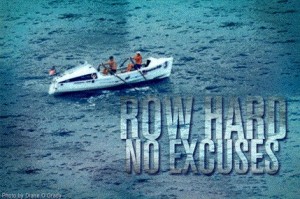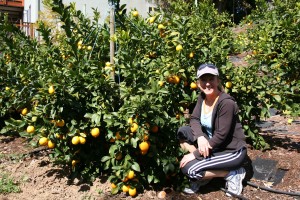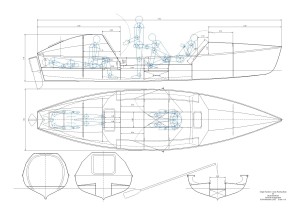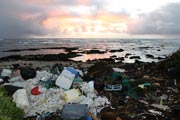
This coming Sunday, March 16, I will appearing at the Tiburon International Film Festival.
I will be taking part in a Q&A after the ocean rowing film Row Hard No Excuses, due to screen at 1.30pm at the Corinthian Yacht Club.
I don't appear in the film - it is about two American men who competed in the 2001 race - but I'm there as a token ocean rower to answer any questions from the audience.
Tickets can be purchased in advance by clicking here.
|
|

I like to shop local when I can, to save on food miles as well as ensuring I'm eating good fresh produce, so I was delighted when Karen Morss agreed to donate 50 lemons to the cause. Karen's sweet Meyer lemons are organically grown just a few miles from my current temporary home in Woodside. A half dozen have now been incorporated into some buckwheat crackers (lemon and asparagus flavour) that are drying out in my dehydrator as I write.
As well as lemons, I got a hefty dollop of inspiration when I went to meet her. Karen is a one-woman dynamo. At about five foot nothing, she makes up for lack of height with an abundance of energy. After running her own software company for 20 years, she decided to get her pilot's license. But she didn't think the flight school was up to scratch. So she bought it and improved it until it was good enough - acquiring a test pilot husband into the bargain.
She'd promised herself 5 years with the flight school, and true to her word, she sold it on the 5th anniversary of the purchase. Then she wrote a screenplay for a movie about the Wright Brothers (still to be made), which involved reading 2400 pages of handwritten letters written by their sister. And now she grows lemons. She rattled off her life story with a briskness that I suspect she brings to all her dealings. I imagine problems and obstacles get very short shrift.
This is her first year of lemon production, and already the yield from 40 tiny trees is exceeding all expectations - which pretty much sums up Karen's life.
I asked Karen what her one top tip for success in business would be. This is what she said:
My father said it best when he told me he would rather see me sell apples on a streetcorner than become the VP of General Motors. That way I would always make my own destiny. I am a big believer in making destinies! If you can dream it, you can believe it. If you can believe it, you can do it.
Photo: Each of the trees is named after a woman who has inspired Karen at some stage of her life, and I was immensely flattered when she asked if she could name a tree in my honour. So after Roz the Albatross, we now have Rosalind the Lemon Tree. The photo shows me with my namesake. I'm the one on the right.
|
|

Last summer my boat was nearly rescued by Steve Fossett's yacht, the Cheyenne. Now the Cheyenne's crew may be coming to my rescue in a rather different way...
Last year's Pacific bid ended prematurely due to large waves and the loss of my sea anchor causing my boat to capsize. It seemed to me at the time that the waves were no larger than anything that I had encountered on the Atlantic, so it seemed likely that the cause of my problems was all the extra bits and pieces that had accumulated on the roof of my cabins - aerials, antennae, weather stations, and a considerably heavier pair of spare oars. (After all 4 of my oars broke on the Atlantic, I had opted for solid ash oars rather than hollow tubes of carbon fibre.) None of these items were a major weight in themselves, but the cumulative total was apparently enough to shift the centre of gravity upwards - leading to capsize.
So I've been talking with Nancy from the Cheyenne, a dab hand in glass fibre work, who is on standby to do the work as soon as we have finalized the specification.
And I've been on the phone to Devon in England talking to Phil Morrison, the original designer of the hull, to ask his advice on how much weight might be needed, and where it should be distributed. It has been invaluable finding out more about the why and the wherefore of the hull design. For example, I learned that the intention is that when a big wave broadsides the boat, rather than the hull 'digging in' to the water and the boat tipping over, the hull is designed to skid sideways across the water, while the boat remains upright - provided, of course, that the centre of gravity is in the right place.
At first I thought we were going to have to add a kind of false bottom to the boat - laying a lead pipe (or similar) along the central ridge that runs the length of the hull, and then glassing it in. But then it occurred to me that several of the hatches along the centre line have flat bottoms, so there is presumably an empty air space between the hatch floors and the hull - so now we are exploring the possibility of creating access to these areas via the hatches and inserting ballast from above. This would be much simpler - and hence cheaper.
I have just 3 months now before I go on standby to depart. Rick Shema, my weather guy, tells me that this is an El Nina year. Although the effects of La Nina will be diminishing by summer, it could still cause higher-than-average winds, and hence waves. So if I am to avoid a repeat of last year's washing machine simulation, a rebalancing of the boat is top priority.
|
|

This article in today's New York Times asks when governments and global organizations are going to step in and save the oceans. It's a valid question, and undoubtedly more should be happening at the highest levels.
But governments and large organizations move slowly, and change direction even more slowly. In the meantime the oceans are deteriorating day by day.
Individuals and small organizations can respond much more quickly - taking immediate action by voting through our everyday actions, like saying No to plastic bags and disposable items, and making sure that we eat only fish from non-threatened species.
Grassroots actions can also create pressure upwards to show governments that we care what kind of a world we live in.
So although governments DO need to act, let's not sit on our hands and wait while the oceans die...
Here is an example of what people are doing to take action: when I was in Hawaii I met the staff of BEACH - Beach Environmental Awareness Campaign Hawaii. There are only two of them, but look what they are doing!
Now, even if you don't have time, or live too far away, to help clean a beach - who can honestly say that they don't have time to pick up a piece of litter when they see it in the street, and put it in the nearest bin? That piece of litter could otherwise end up in the drains, washing into a river, flowing to the sea... and choking an albatross. You never know the good you might do. I like to think of it as the Ripple Effect...
[photo: not what we imagine a Hawaii beach to look like]
|
|